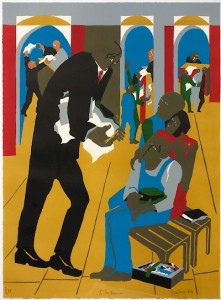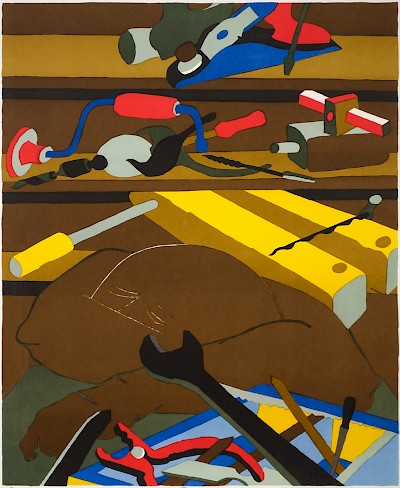
Jacob Lawrence as Printmaker
April 28th – May 30th, 2015
Davidson Galleries, Washington.
To the defense, 1989.
About:
Born in Atlantic City, New Jersey, Jacob Lawrence (1917-2000) moved with his family to Harlem in 1930, where he came into contact with some of the greatest artistic and intellectual minds of his generation. During the previous decade, Harlem had experienced the rich period known as the Harlem Renaissance, and the neighborhood was still the focal point of African American culture. Before he was twenty years old, Lawrence developed a powerful, concise style that expressed all of the vibrancy and pathos of his neighborhood and its occupants.
 Carpenters, 1977.
Carpenters, 1977.
From his first published lithograph in 1963, Lawrence produced a dynamic body of prints exploring universal issues of equality, unity, and hope in a distinctive, personal style of bold colors and flat, overlapping shapes influenced by Modern art. He often described his work as a continuation, constantly growing and building on itself; many of his prints rework themes and compositions from his paintings. This exhibition of etchings, woodcuts, silkscreens, and lithographs—almost all of his printed works—is from the artist’s estate. Included are the complete series of The Life of Toussaint L’Ouverture and The Legend of John Brown as well as single images of still lifes, athletes, builders, families, and voters.
Lawrence became nationally known when The Migration of the Negro series was shown at New York’s Downtown Gallery in 1941. The first African American artist to be represented by a New York gallery, he was also the subject of a lengthy profile in Fortune magazine, which reproduced twenty-six of the series’ sixty panels. The Museum of Modern Art and the Phillips Collection in Washington, D.C. bought the complete series upon the close of the exhibition.
 The Builders, 1974.
The Builders, 1974.
Drafted into the Coast Guard, he served in WWII from 1943 to 1945. Lawrence was assigned to duty as a combat artist. After his discharge, he returned to Harlem and resumed painting city life. During the 1940s, he taught at the influential Black Mountain College, received a Guggenheim Foundation grant, and was commissioned by Fortune to paint ten canvases examining conditions in the South. During the 1950s and 60s, Lawrence’s work was characterized by stylistic experimentation and everyday imagery. He and his artist wife Gwendolyn Knight moved to Seattle when he was hired to teach at the University of Washington in 1971.
 The March, 1995.
The March, 1995.
Lawrence became interested in limited edition prints in the 1960s. Like many artists, he appreciated the fact that because prints can be made in multiples at low cost, more people can afford them. In the 1930s, he trained with the Works Progress Administration. Although he didn’t work on a press at the time, he did contribute drawings that were translated into lithographs. The first lithograph he made in 1963 was based on one of his paintings, setting up a pattern he would follow in the future. As he experimented with lithography, drypoint, etching, and silkscreen, his work evolved from an emphasis on drawing to a shift in focus on color and form. By the early 1970s, he fully incorporated the rich, vibrant color for which he is known.
 Tools, 1977.
Tools, 1977.
He chose his printing process based on the mood he wished to create and the subject he was treating. As you look at the prints on this wall, compare the differences that result from the artistic decisions he made. (text Hudson River Museum)
